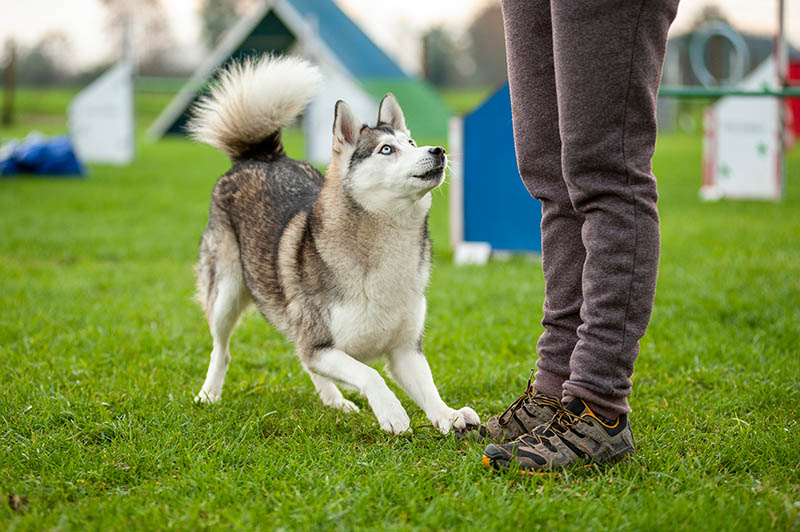Barking is one of most dog owners’ major complaints about their best buds. Barking can be disruptive and taxing on the spirit—but more so, hard to correct. So, what exactly causes excessive barking, and how can you make it stop?
In this article, we’d love to set your expectations, explain the importance of barking, and encourage adequate training. We hope you can find these tips useful for your situation.
How to Train a Dog to Stop Barking on Command
1. Learn About Barking
Barking is a natural instinct for dogs. It is a human tool that they use to speak with their humans and other animals. Expecting a dog never to vocalize is unrealistic, as it is taking away a part of their natural identity.
For them to be ashamed of barking is unhealthy and can lead to a lot of unhealthy behaviors. However, there are ways to encourage healthy barking and discourage unnecessary barking. All it takes is a little motivation, patience, and proper training on the owner’s end.
If you are interested in decreasing your dog’s bark volume and frequency, you can check out these tips, but remember that you should never want to eliminate the behavior completely. Our dogs should be allowed to bark if it is appropriate, and we must teach them when it is appropriate and when it isn’t.

2. Understand the Breed
When barking is a problem, you need to look at the breed. It is important to understand exactly what that dog is all about because some breeds are more prone to barking than others. Some dogs rarely bark at all.
For example, the Basenji is known as the barkless dog. This dog is essentially one that will not bark at all, even if there is very good reason to do so. They might draw attention to something going on, but they typically don’t vocalize.
The exact opposite could be said for a notoriously talkative breed like the Husky. This dog literally thrives on vocal communication and absolutely cannot be trained against their natural instinct.
Having said that, there are dogs that lie on a spectrum when it comes to barking. Personality plays a huge role, as do genetics and other environmental factors. The rule of thumb when it comes to knowing how much a dog will bark is looking at the probability based on breed. The below lists are not all-inclusive, but below are some dog breeds that tend to bark more or less.
3. Pinpoint Primary Triggers
What exactly really gets your dog going? Is it the squirrels out the window? A knock at the door? A neighbor passing by? Or just anything and everything that they possibly find stimulating?
Once you know what really gets your dog going, you can diligently work towards creating a less stimulating environment by providing appropriate training. It is crucial to desensitize your dog and teach them to appropriately respond to outer stimuli.

4. Choose a Single Command
If you’re trying to train your dog not to bark, the easiest way to do this is to choose a single word and use it solely when you are referencing the command. For example, you could choose a simple word, like “stop.” You could even use something more general, like “no.”
But every time the dog barks inappropriately, you have to correct the behavior with the specific command and follow through with other means of reinforcing the command, such as treats and praise. If you use the command every time your dog barks at a certain trigger, such as seeing a squirrel outside, and the dog stops barking, give them a treat. Likewise, don’t use the command if you want them to bark when there’s a knock at the door, so they know that it’s okay to keep barking in this situation. They will eventually learn what they should bark at and what they shouldn’t as long as you keep using the command and reinforcing with treats when appropriate.
We highly recommend never treating barking with aggression. In certain dogs, negative connotations associated with your training methods can actually increase the risk for poor behavior. It’s important to treat your dog with respect while letting them know who is boss.
You build a stronger bond by choosing a simple command and working diligently with your pup to get the desired results.
5. Encourage Healthy Barking
Encourage healthy barking? Whatever could this mean? Dogs should bark. It’s a natural characteristic of their species. Just like animals in the wild communicate with one another with different vocalizations and body language, our dogs do the same. This is why it’s important to train them as to when it’s okay to bark and when it isn’t.
Barking is very much an expected part of dog owning. You simply have to learn how to navigate around it. With extreme barkers, this can be very complicated, and you might feel like you just want to pull your hair out!

6. Ensure Your Dog Gets Adequate Exercise
You might not necessarily equate barking with exercise. However, a dog that has a lot of pent-up energy is more inclined to neurotic behaviors, like barking, chewing, destructiveness in general, and separation anxiety.
If you have a high-energy breed that just isn’t burning enough steam in a day, anything that moves can overstimulate them. If you find that this is happening, you can always up the exercise regimen and make sure that your dog is very tuckered out by the end of the day.
This could eliminate many of these bad behaviors and make it much easier and quieter to live with your dog. The amount of exercise your dog needs depends greatly on its breed, size, health, and age. Your veterinarian can recommend an exact number based on these factors. Your vet might also recommend certain stimulating games to capture their focus.
7. Seek Professional Training
When all else fails, it’s time to seek professional training. Barking is something that is easily fixed, permitting you channel the situation correctly.
Professional trainers deal with these sorts of issues on a daily basis and have all the tools and resources necessary to help you achieve your goals. Oftentimes, trainers will recommend that you work alongside your canine companion to solidify that bond and put an equal effort into training.
Others prefer that you leave the dog at their facility while they train. If you prefer to do it at home yourself, you can also find free training resources online, but with the indirect help of a professional.
Ultimately, you will choose the best trainer for your intentions and budget. You can be very communicative with them, letting them know exactly what you hope to achieve with training so the two of you can come up with a proper plan. Don’t be afraid to ask for recommendations in your area.


Conclusion
Now, you can ensure that your dog stops barking when you command it and allow them to bark when it’s appropriate. It can be difficult for your dog to learn at first, but as long as you’re diligent and consistent, you can decrease barking.
Remember to choose the right breed before you even run into barking issues. Then, simply work on training, training, training—it’s key!
Featured Image Credit: Serhii Yushkov, Shutterstock











